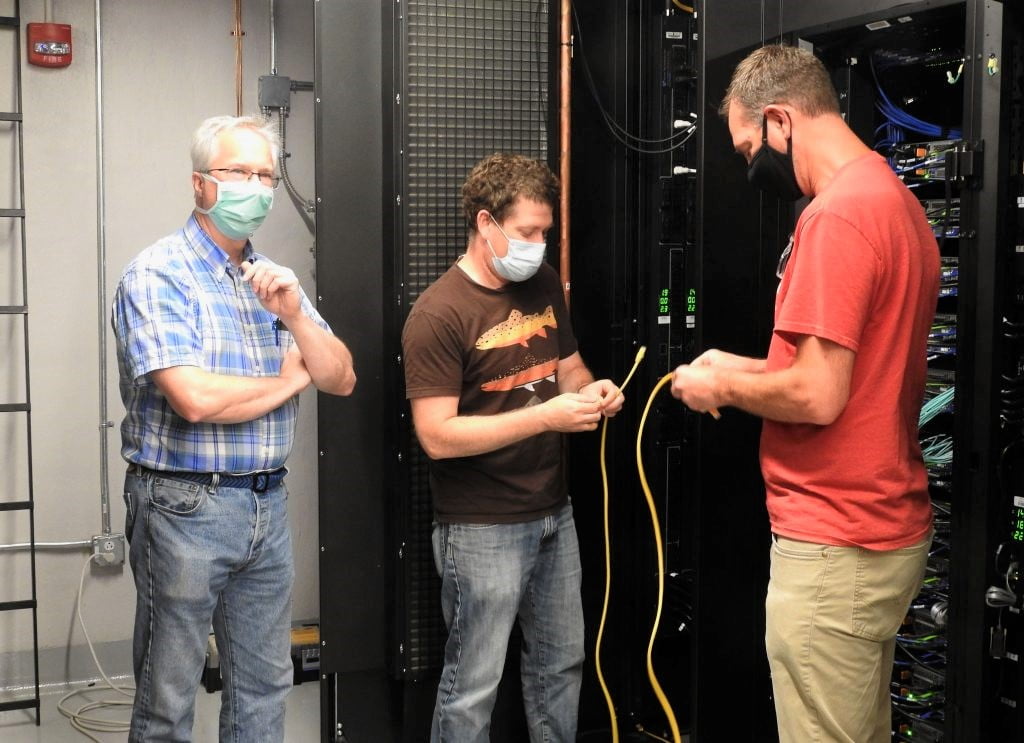
Virginia Tech has a history of breaking boundaries when it comes to supercomputing.
In 2003, System X debuted as the world’s largest supercomputer housed at a university. A decade later, HokieSpeed brought new capabilities for visualization and machine learning, while the BlueRidge cluster provided unprecedented capacity for computational research at the university.
Where size and power are concerned, however, all of these pale in comparison to TinkerCliffs, Virginia Tech’s new flagship high-performance computing (HPC) system, which is now available to the university community through Advanced Research Computing (ARC), a unit of the Division of Information Technology. With this addition, ARC now offers five supercomputing clusters to meet the broad research needs of the Virginia Tech community.
“Access to advanced high-performance computing is critical to the success of a growing number of Virginia Tech’s researchers and research institutes and centers,” explained Scott Midkiff, vice president for information technology and chief information officer. “TinkerCliffs and other ARC systems provide that access needed to remain competitive in computation-based research.”
Terry Herdman, associate vice president for research computing, said, “Since the installation of BlueRidge in 2013, the demand for HPC resources at Virginia Tech has consistently increased. Our users asked for a powerful central processing unit (CPU) cluster to help them complete larger and more complex operations.
“TinkerCliffs is a true ‘workhorse’ cluster that will provide the computing capacity for our users to advance their research, which in turn will strengthen their ability to secure external funding in a competitive research environment.”
Thanks to the latest high-density technology, TinkerCliffs provides nearly 10 times the computing power of its predecessor.
A key factor that sets TinkerCliffs apart from previous supercomputers at Virginia Tech is its considerably higher density, which provides capabilities unavailable just a few years ago. TinkerCliffs contains 128 cores per node, whereas BlueRidge contained 16 cores per node. This density enables researchers to employ multiple modalities to tackle very large and complex calculations, simulations, and models — and a large number of these at a time — far more quickly and efficiently than with previous clusters.
Like any technology, HPC hardware is constantly evolving, allowing for more sophisticated computational research methods. To ensure that Virginia Tech researchers have access to the most capable HPC infrastructure to meet increasingly complex and demanding research needs, ARC upgrades its clusters on a regular basis.
Computational scientist Justin Krometis said, “You can’t really find anything newer than what we have in TinkerCliffs.”
The cluster was originally slated to be installed in April 2020 and made available for use by early summer. However, even supercomputers are not immune from the manufacturing and supply chain issues experienced by almost every industry in the wake of the COVID-19 pandemic.
“Parts for the cluster were delayed due to the pandemic,” said Kevin Shinpaugh, director of HPC operations for ARC. “While the original plan was to build the cluster and install software at the factory, eventually we made the decision to have the system built and shipped to Virginia Tech, so that we could meet our delivery deadline. This meant we had to finish the process of installing and testing the software on site.”
Ying Zhou, associate professor of geophysics for the College of Science, was one of the first to perform computational research using TinkerCliffs. She has already noticed a difference in how the cluster can handle the complex operations that her research demands.
“This new cluster will definitely accelerate discoveries in the Earth sciences,” Zhou said. “For example, we are now able to simulate hundreds of earthquakes in a couple of days. Those waveform data will provide critical constraints for imaging the interior of Earth at a global scale, including the planet’s mantle and core.”


